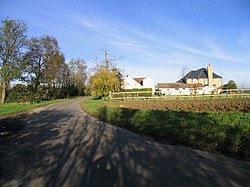Beauchamp Roding
| Beauchamp Roding | |
| Essex | |
|---|---|
 Beauchamp Roding | |
| Location | |
| Grid reference: | TL5810 |
| Location: | 51°46’1"N, -0°17’17"E |
| Data | |
| Post town: | Ongar |
| Postcode: | CM5 |
| Local Government | |
| Council: | Epping Forest |
Beauchamp Roding (pronounced Beecham) is a village and ancient parish in Essex. Together with Abbess Roding and Berners Roding it forms the civil parish of Abbess, Beauchamp and Berners Roding. The village is included in the eight hamlets and villages called The Rodings. Beauchamp Roding is eight miles west of the county town of Chelmsford. The ancient parish is mostly in Ongar hundred, but the area around Birds Green in the south-east lies within Dunmow hundred.
History
According to A Dictionary of British Place Names, Roding derives from "Rodinges" as is listed in the Domesday Book, with the later variation 'Royenges Beauchamp' recorded in 1238. The 'Beauchamp' refers to the manorial possession by a family called 'de Beauchamp' held under the ownership of the Abbess of Barking.[1]
In the Domesday account Beauchamp Roding held 15 households, two villagers, 13 smallholders, 50 acres of meadow and 200 pigs. Before the Conquest, the lordship was held by Edsi and Leofwin; after given to Aubrey de Vere, with Count Alan of Brittany as Tenant-in-chief to William the Conqueror.[2]
The traditional name for the village was Beauchamp Roothing. The registers of the church of St Botolph date to 1688. The church, which was restored in 1867, had attached an 1882 living of a rectory with residence for the priest. There was also a parish school. The area in and around the village had one principal landowner. Crops grown at the time were chiefly wheat, barley and beans, on a heavy soil with a clay subsoil. There was a land area of 1,311 acres supporting an 1881 population of 231. Occupations included a beer retailer, a farm bailiff, five farmers, one of whom was a hay dealer and the licensee of the Swan Inn public house, and another farming at Butt Hatch. Also at Butt Hatch was a shopkeeper.[3]
The hamlet of Birds Green in the parish to the south of the village is partly in the parish of Willingale Doe, but entirely within Dunmow hundred.
References
- ↑ Mills, Anthony David (2003); A Dictionary of British Place Names, Oxford University Press, revised edition (2011), p.392. ISBN 019960908X
- ↑ "Beauchamp Roding", Open Domesday, University of Hull. Retrieved 9 February 2018
- ↑ Kelly's Directory of Essex 1882 pp.245-247
Outside links
| ("Wikimedia Commons" has material about Beauchamp Roding) |
- Abbess, Beauchamp and Berners Roding Parish Council official website including Beauchamp Roding description. Retrieved 10 February 2018
